The Cambridge History of China. Vol. 12: Republican China, 1912-1949, Part 1
Подождите немного. Документ загружается.

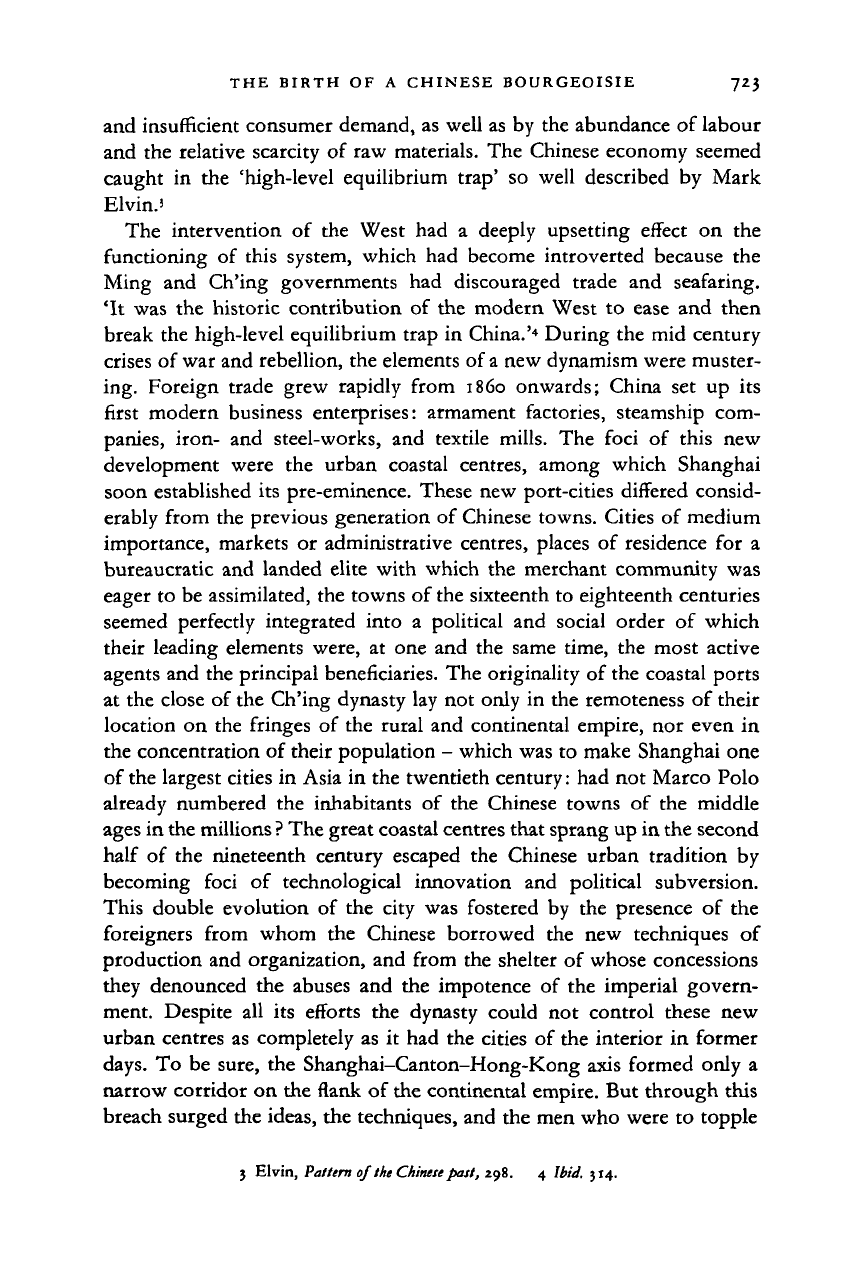
THE BIRTH OF A CHINESE BOURGEOISIE 723
and insufficient consumer demand, as well as by the abundance of labour
and the relative scarcity of raw materials. The Chinese economy seemed
caught in the 'high-level equilibrium trap' so well described by Mark
Elvin.'
The intervention of the West had a deeply upsetting effect on the
functioning of this system, which had become introverted because the
Ming and Ch'ing governments had discouraged trade and seafaring.
'It was the historic contribution of the modern West to ease and then
break the high-level equilibrium trap in China.'
4
During the mid century
crises of war and rebellion, the elements of
a
new dynamism were muster-
ing. Foreign trade grew rapidly from i860 onwards; China set up its
first modern business enterprises: armament factories, steamship com-
panies, iron- and steel-works, and textile mills. The foci of this new
development were the urban coastal centres, among which Shanghai
soon established its pre-eminence. These new port-cities differed consid-
erably from the previous generation of Chinese towns. Cities of medium
importance, markets or administrative centres, places of residence for a
bureaucratic and landed elite with which the merchant community was
eager to be assimilated, the towns of the sixteenth to eighteenth centuries
seemed perfectly integrated into a political and social order of which
their leading elements were, at one and the same time, the most active
agents and the principal beneficiaries. The originality of the coastal ports
at the close of the Ch'ing dynasty lay not only in the remoteness of their
location on the fringes of the rural and continental empire, nor even in
the concentration of their population - which was to make Shanghai one
of the largest cities in Asia in the twentieth century: had not Marco Polo
already numbered the inhabitants of the Chinese towns of the middle
ages in the millions
?
The great coastal centres that sprang up in the second
half of the nineteenth century escaped the Chinese urban tradition by
becoming foci of technological innovation and political subversion.
This double evolution of the city was fostered by the presence of the
foreigners from whom the Chinese borrowed the new techniques of
production and organization, and from the shelter of whose concessions
they denounced the abuses and the impotence of the imperial govern-
ment. Despite all its efforts the dynasty could not control these new
urban centres as completely as it had the cities of the interior in former
days.
To be sure, the Shanghai-Canton-Hong-Kong axis formed only a
narrow corridor on the flank of the continental empire. But through this
breach surged the ideas, the techniques, and the men who were to topple
5 Elvin, Pattern of
the Chinese
past, 298. 4
Ibid.
314.
Cambridge Histories Online © Cambridge University Press, 2008
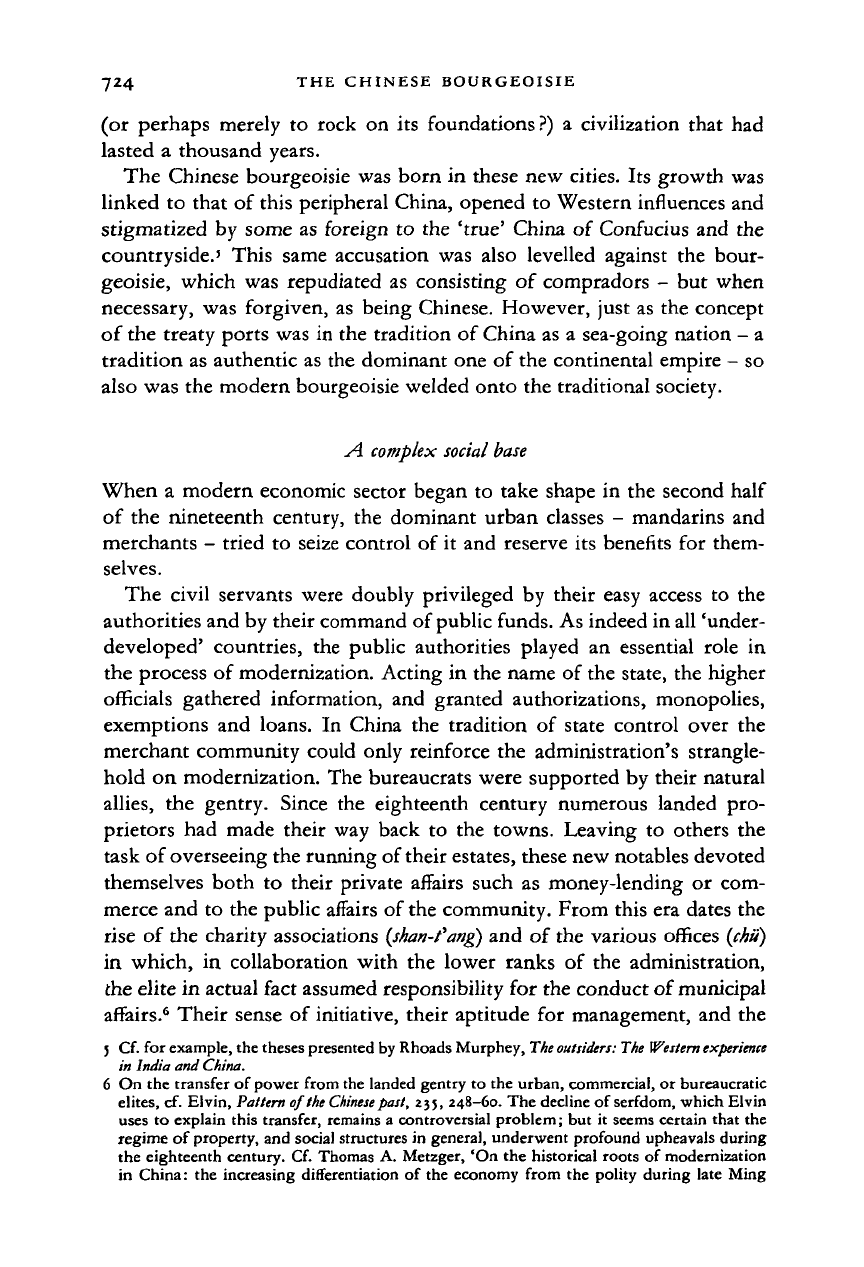
724 THE CHINESE BOURGEOISIE
(or perhaps merely
to
rock
on its
foundations?)
a
civilization that had
lasted
a
thousand years.
The Chinese bourgeoisie was born in these new cities. Its growth was
linked
to
that
of
this peripheral China, opened
to
Western influences and
stigmatized
by
some as foreign
to
the 'true' China
of
Confucius and the
countryside.' This same accusation was also levelled against
the
bour-
geoisie, which was repudiated
as
consisting
of
compradors
-
but when
necessary, was forgiven,
as
being Chinese. However, just as the concept
of the treaty ports was in the tradition
of
China as
a
sea-going nation
- a
tradition as authentic as the dominant one
of
the continental empire
- so
also was the modern bourgeoisie welded onto the traditional society.
A.
complex social
base
When
a
modern economic sector began
to
take shape
in
the second half
of the nineteenth century,
the
dominant urban classes
-
mandarins and
merchants
-
tried
to
seize control
of it
and reserve its benefits
for
them-
selves.
The civil servants were doubly privileged
by
their easy access
to the
authorities and by their command of public funds. As indeed in all 'under-
developed' countries,
the
public authorities played
an
essential role
in
the process
of
modernization. Acting
in
the name
of
the state, the higher
officials gathered information,
and
granted authorizations, monopolies,
exemptions
and
loans.
In
China
the
tradition
of
state control over
the
merchant community could only reinforce the administration's strangle-
hold
on
modernization. The bureaucrats were supported by their natural
allies,
the
gentry. Since
the
eighteenth century numerous landed pro-
prietors
had
made their way back
to the
towns. Leaving
to
others
the
task of overseeing the running of their estates, these new notables devoted
themselves both
to
their private affairs such
as
money-lending
or
com-
merce and to the public affairs of the community. From this era dates the
rise
of
the charity associations
(shan-t'ang)
and
of
the various offices
(chu)
in which,
in
collaboration with
the
lower ranks
of
the administration,
the elite in actual fact assumed responsibility for the conduct of municipal
affairs.
6
Their sense
of
initiative, their aptitude
for
management, and the
5 Cf. for example, the theses presented by Rhoads Murphey,
The
outsiders:
The Western experience
in India and
China.
6 On the transfer of power from the landed gentry
to
the urban, commercial, or bureaucratic
elites,
cf.
Elvin, Pattern of
the Chinese
past, 235, 248—60. The decline
of
serfdom, which Elvin
uses
to
explain this transfer, remains
a
controversial problem; but
it
seems certain that the
regime
of
property, and social structures in general, underwent profound upheavals during
the eighteenth century.
Cf.
Thomas
A.
Metzger, 'On the historical roots
of
modernization
in China:
the
increasing differentiation
of
the economy from the polity during late Ming
Cambridge Histories Online © Cambridge University Press, 2008
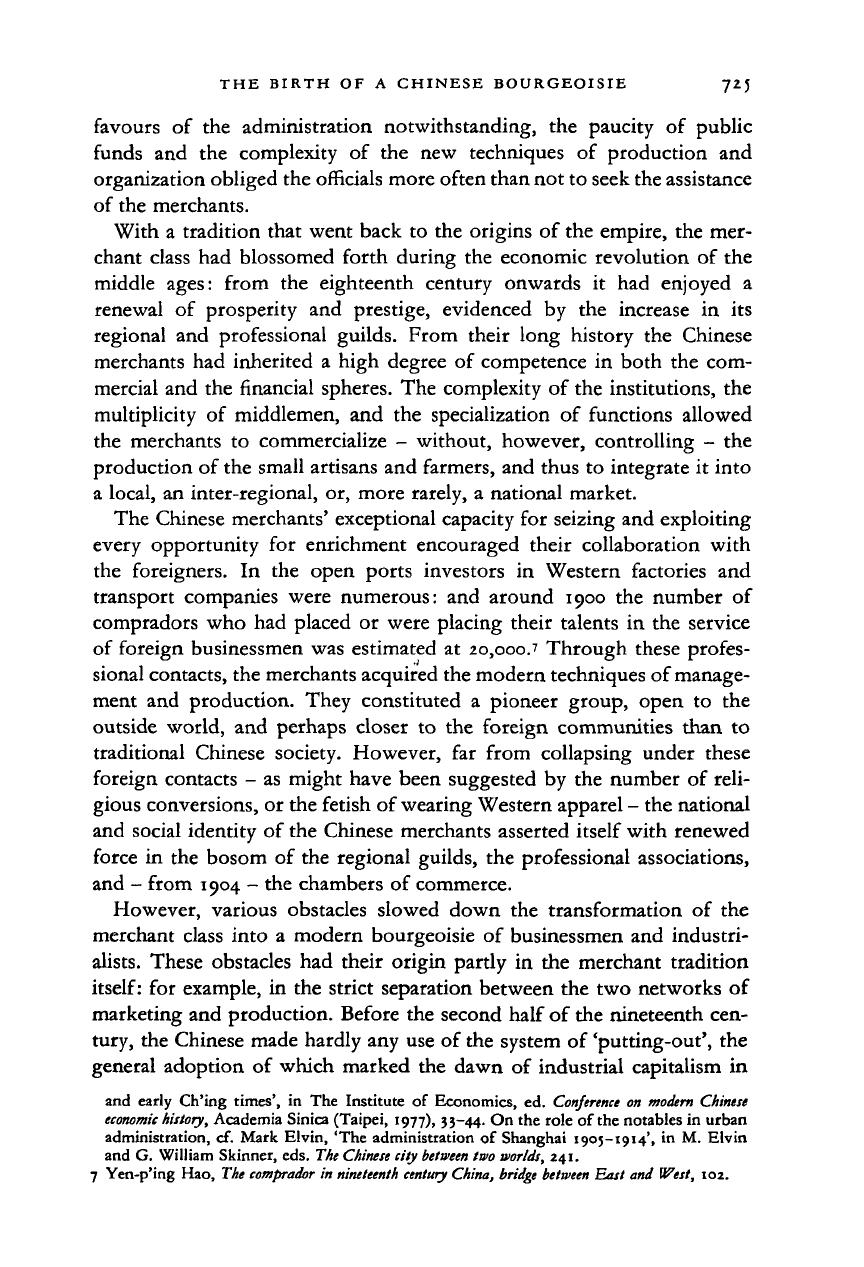
THE BIRTH OF A CHINESE BOURGEOISIE 725
favours of the administration notwithstanding, the paucity of public
funds and the complexity of the new techniques of production and
organization obliged the officials more often than not to seek the assistance
of the merchants.
With a tradition that went back to the origins of the empire, the mer-
chant class had blossomed forth during the economic revolution of the
middle ages: from the eighteenth century onwards it had enjoyed a
renewal of prosperity and prestige, evidenced by the increase in its
regional and professional guilds. From their long history the Chinese
merchants had inherited a high degree of competence in both the com-
mercial and the financial spheres. The complexity of the institutions, the
multiplicity of middlemen, and the specialization of functions allowed
the merchants to commercialize - without, however, controlling - the
production of the small artisans and farmers, and thus to integrate it into
a local, an inter-regional, or, more rarely, a national market.
The Chinese merchants' exceptional capacity for seizing and exploiting
every opportunity for enrichment encouraged their collaboration with
the foreigners. In the open ports investors in Western factories and
transport companies were numerous: and around 1900 the number of
compradors who had placed or were placing their talents in the service
of foreign businessmen was estimated at 20,000.f Through these profes-
sional contacts, the merchants acquired the modern techniques of manage-
ment and production. They constituted a pioneer group, open to the
outside world, and perhaps closer to the foreign communities than to
traditional Chinese society. However, far from collapsing under these
foreign contacts - as might have been suggested by the number of reli-
gious conversions, or the fetish of wearing Western apparel - the national
and social identity of the Chinese merchants asserted itself with renewed
force in the bosom of the regional guilds, the professional associations,
and - from 1904 - the chambers of commerce.
However, various obstacles slowed down the transformation of the
merchant class into a modern bourgeoisie of businessmen and industri-
alists.
These obstacles had their origin partly in the merchant tradition
itself:
for example, in the strict separation between the two networks of
marketing and production. Before the second half of the nineteenth cen-
tury, the Chinese made hardly any use of the system of 'putting-out', the
general adoption of which marked the dawn of industrial capitalism in
and early Ch'ing times', in The Institute of Economics, ed.
Conference
on
modern Chinese
economic
history,
Academia Sinica (Taipei, 1977), 33-44. On the role of the notables in urban
administration, cf. Mark Elvin, 'The administration of Shanghai 1905-1914', in M. Elvin
and G. William Skinner, eds.
The Chinese
city
between
two
worlds,
241.
7 Yen-p'ing Hao,
The comprador
in
nineteenth century
China,
bridge between
East and West, 102.
Cambridge Histories Online © Cambridge University Press, 2008
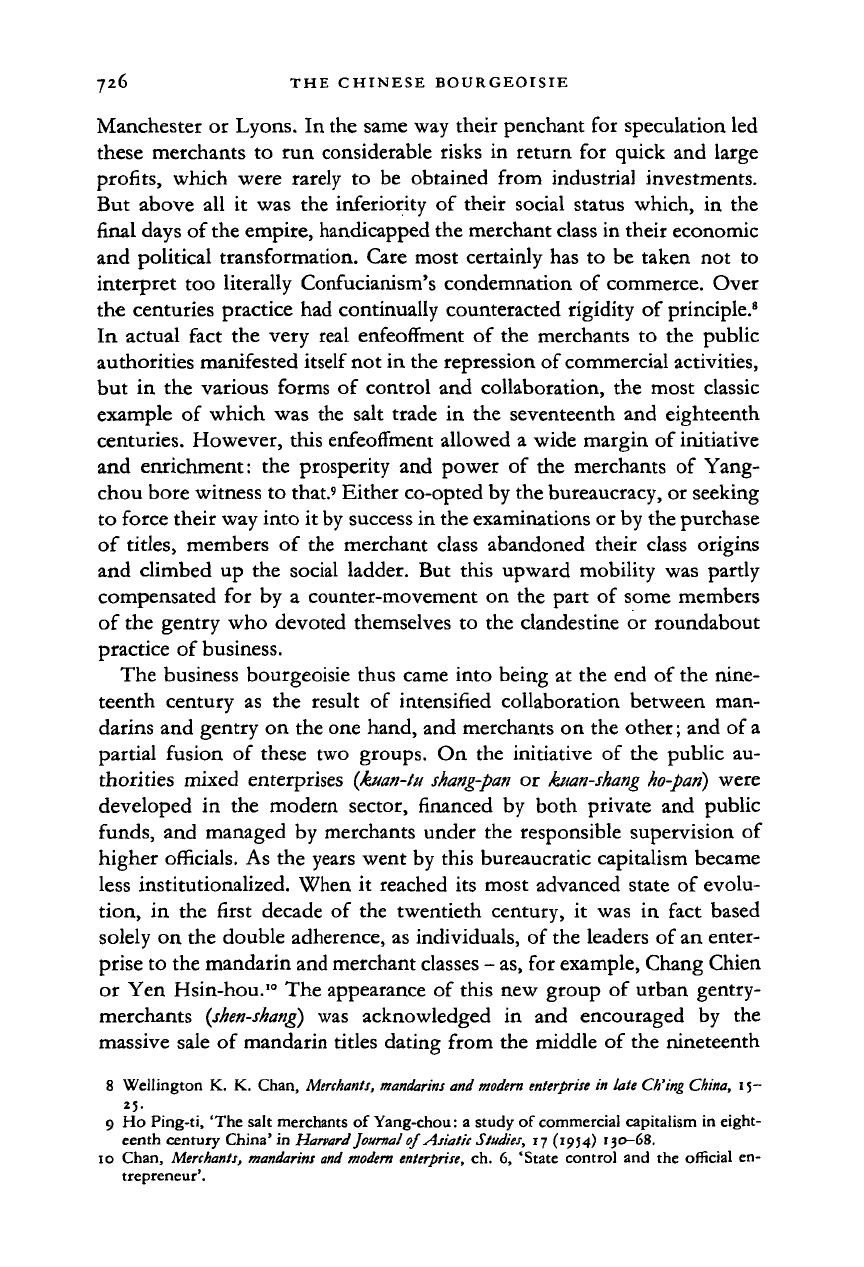
726 THE CHINESE BOURGEOISIE
Manchester
or
Lyons.
In
the same way their penchant
for
speculation led
these merchants
to run
considerable risks
in
return
for
quick
and
large
profits, which were rarely
to be
obtained from industrial investments.
But above
all it was the
inferiority
of
their social status which,
in the
final days
of
the empire, handicapped the merchant class in their economic
and political transformation. Care most certainly
has to be
taken
not to
interpret
too
literally Confucianism's condemnation
of
commerce. Over
the centuries practice had continually counteracted rigidity
of
principle.
8
In actual fact
the
very real enfeoffment
of the
merchants
to the
public
authorities manifested itself not
in
the repression
of
commercial activities,
but
in the
various forms
of
control
and
collaboration,
the
most classic
example
of
which
was the
salt trade
in the
seventeenth
and
eighteenth
centuries. However, this enfeoffment allowed
a
wide margin
of
initiative
and enrichment:
the
prosperity
and
power
of the
merchants
of
Yang-
chou bore witness
to
that.
9
Either co-opted by the bureaucracy,
or
seeking
to force their way into
it
by success in the examinations or by the purchase
of titles, members
of the
merchant class abandoned their class origins
and climbed
up the
social ladder.
But
this upward mobility
was
partly
compensated
for by a
counter-movement
on the
part
of
some members
of the gentry who devoted themselves
to the
clandestine
or
roundabout
practice
of
business.
The business bourgeoisie thus came into being
at the end of
the nine-
teenth century
as the
result
of
intensified collaboration between
man-
darins
and
gentry
on
the one hand,
and
merchants
on
the other;
and of
a
partial fusion
of
these
two
groups.
On the
initiative
of the
public
au-
thorities mixed enterprises {kuan-tu shang-pan
or
kuan-shang ho-pan) were
developed
in the
modern sector, financed
by
both private
and
public
funds,
and
managed
by
merchants under
the
responsible supervision
of
higher officials.
As the
years went
by
this bureaucratic capitalism became
less institutionalized. When
it
reached
its
most advanced state
of
evolu-
tion,
in the
first decade
of the
twentieth century,
it was in
fact based
solely
on
the double adherence,
as
individuals,
of
the leaders
of
an enter-
prise
to
the mandarin and merchant classes
-
as,
for
example, Chang Chien
or
Yen
Hsin-hou.'° The appearance
of
this
new
group
of
urban gentry-
merchants
(shen-shang)
was
acknowledged
in and
encouraged
by the
massive sale
of
mandarin titles dating from
the
middle
of
the nineteenth
8 Wellington
K. K.
Chan,
Merchants,
mandarins
and
modern enterprise
in
late Ch'ing China, 15—
25-
9
Ho
Ping-ti, 'The salt merchants
of
Yang-chou:
a
study
of
commercial capitalism in eight-
eenth century China'
in
Harvard
Journal
of Asiatic
Studies,
17 (1954) 130-68.
10 Chan,
Merchants,
mandarins and modern
enterprise,
ch. 6,
'State control
and the
official
en-
trepreneur'.
Cambridge Histories Online © Cambridge University Press, 2008
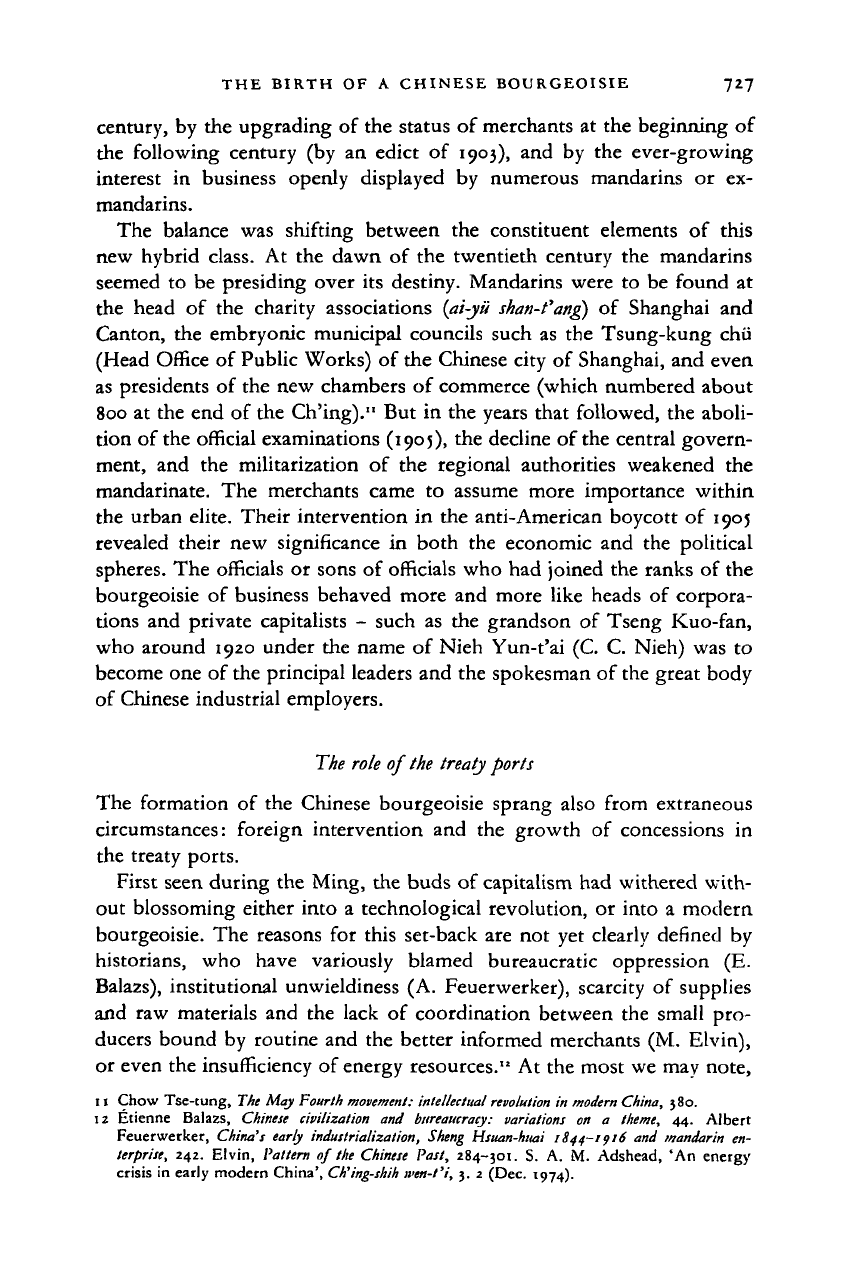
THE BIRTH OF A CHINESE BOURGEOISIE 727
century, by the upgrading of the status of merchants
at
the beginning of
the following century (by
an
edict
of
1903), and
by the
ever-growing
interest
in
business openly displayed
by
numerous mandarins
or ex-
mandarins.
The balance
was
shifting between
the
constituent elements
of
this
new hybrid class.
At
the dawn
of
the twentieth century the mandarins
seemed
to
be presiding over its destiny. Mandarins were
to
be found
at
the head
of
the charity associations (ai-jii
shan-t'ang)
of
Shanghai
and
Canton, the embryonic municipal councils such as the Tsung-kung chii
(Head Office of Public Works) of the Chinese city of Shanghai, and even
as presidents
of
the new chambers of commerce (which numbered about
800 at the end of the Ch'ing)." But in the years that followed, the aboli-
tion of the official examinations (1905), the decline of the central govern-
ment,
and the
militarization
of
the regional authorities weakened
the
mandarinate. The merchants came
to
assume more importance within
the urban elite. Their intervention in the anti-American boycott
of
1905
revealed their new significance
in
both the economic and
the
political
spheres. The officials
or
sons of officials who had joined the ranks of the
bourgeoisie
of
business behaved more and more like heads
of
corpora-
tions and private capitalists
-
such
as
the grandson
of
Tseng Kuo-fan,
who around 1920 under the name
of
Nieh Yun-t'ai (C. C. Nieh) was
to
become one of the principal leaders and the spokesman of the great body
of Chinese industrial employers.
The
role
of
the
treaty ports
The formation
of
the Chinese bourgeoisie sprang also from extraneous
circumstances: foreign intervention and
the
growth
of
concessions
in
the treaty ports.
First seen during the Ming, the buds of capitalism had withered with-
out blossoming either into
a
technological revolution,
or
into
a
modern
bourgeoisie. The reasons
for
this set-back are not yet clearly defined
by
historians,
who
have variously blamed bureaucratic oppression
(E.
Balazs), institutional unwieldiness (A. Feuerwerker), scarcity
of
supplies
and raw materials and the lack
of
coordination between the small pro-
ducers bound by routine and the better informed merchants (M. Elvin),
or even the insufficiency of energy resources.
12
At the most we may note,
11 Chow Tse-tung, The May Fourth
movement:
intellectual revolution
in
modern
China, 380.
12 Etienne Balazs, Chinese civilization
and
bureaucracy: variations
on a
theme,
44.
Albert
Feuerwerker, China's early industrialization, Sheng Hsuan-huai 1844-1916 and mandarin en-
terprise, 242. Elvin, Pattern
of
the Chinese Past,
284-301.
S. A. M.
Adshead,
'An
energy
crisis
in
early modern China',
Ch'ing-shih
iven-t'i, 3. 2 (Dec. 1974).
Cambridge Histories Online © Cambridge University Press, 2008
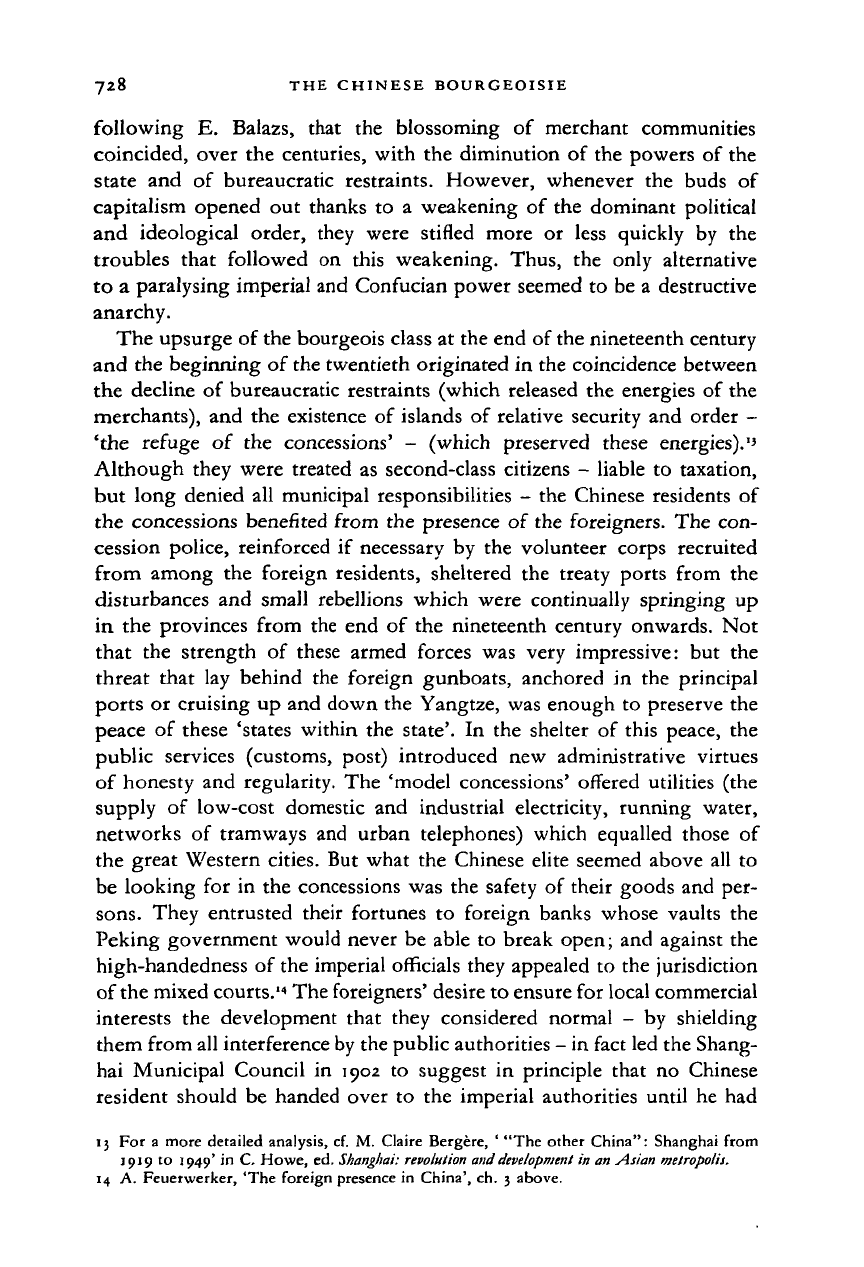
728 THE CHINESE BOURGEOISIE
following
E.
Balazs, that
the
blossoming
of
merchant communities
coincided, over
the
centuries, with
the
diminution
of the
powers
of the
state
and of
bureaucratic restraints. However, whenever
the
buds
of
capitalism opened
out
thanks
to a
weakening
of the
dominant political
and ideological order, they were stifled more
or
less quickly
by the
troubles that followed
on
this weakening. Thus,
the
only alternative
to
a
paralysing imperial and Confucian power seemed
to be a
destructive
anarchy.
The upsurge
of
the bourgeois class
at
the end
of
the nineteenth century
and
the
beginning
of
the twentieth originated
in
the coincidence between
the decline
of
bureaucratic restraints (which released
the
energies
of the
merchants),
and the
existence
of
islands
of
relative security
and
order
-
'the refuge
of the
concessions'
-
(which preserved these energies).
1
'
Although they were treated
as
second-class citizens
-
liable
to
taxation,
but long denied
all
municipal responsibilities
- the
Chinese residents
of
the concessions benefited from
the
presence
of
the foreigners.
The con-
cession police, reinforced
if
necessary
by the
volunteer corps recruited
from among
the
foreign residents, sheltered
the
treaty ports from
the
disturbances
and
small rebellions which were continually springing
up
in
the
provinces from
the end of the
nineteenth century onwards.
Not
that
the
strength
of
these armed forces
was
very impressive:
but the
threat that
lay
behind
the
foreign gunboats, anchored
in the
principal
ports
or
cruising
up and
down
the
Yangtze, was enough
to
preserve
the
peace
of
these 'states within
the
state'.
In the
shelter
of
this peace,
the
public services (customs, post) introduced
new
administrative virtues
of honesty
and
regularity.
The
'model concessions' offered utilities
(the
supply
of
low-cost domestic
and
industrial electricity, running water,
networks
of
tramways
and
urban telephones) which equalled those
of
the great Western cities.
But
what
the
Chinese elite seemed above
all to
be looking
for in the
concessions
was the
safety
of
their goods
and per-
sons.
They entrusted their fortunes
to
foreign banks whose vaults
the
Peking government would never
be
able
to
break open;
and
against
the
high-handedness
of
the imperial officials they appealed
to the
jurisdiction
of the mixed courts.'
4
The foreigners' desire
to
ensure
for
local commercial
interests
the
development that they considered normal
- by
shielding
them from all interference by the public authorities
- in
fact led the Shang-
hai Municipal Council
in 1902 to
suggest
in
principle that
no
Chinese
resident should
be
handed over
to the
imperial authorities until
he had
13
For a
more detailed analysis,
cf. M.
Claire Bergere,
'
"The other China": Shanghai from
1919
to
1949'
in C.
Howe, ed.
Shanghai:
revolution
and
development
in an Asian metropolis.
14
A.
Feuerwerker,
'The
foreign presence
in
China',
ch. 3
above.
Cambridge Histories Online © Cambridge University Press, 2008
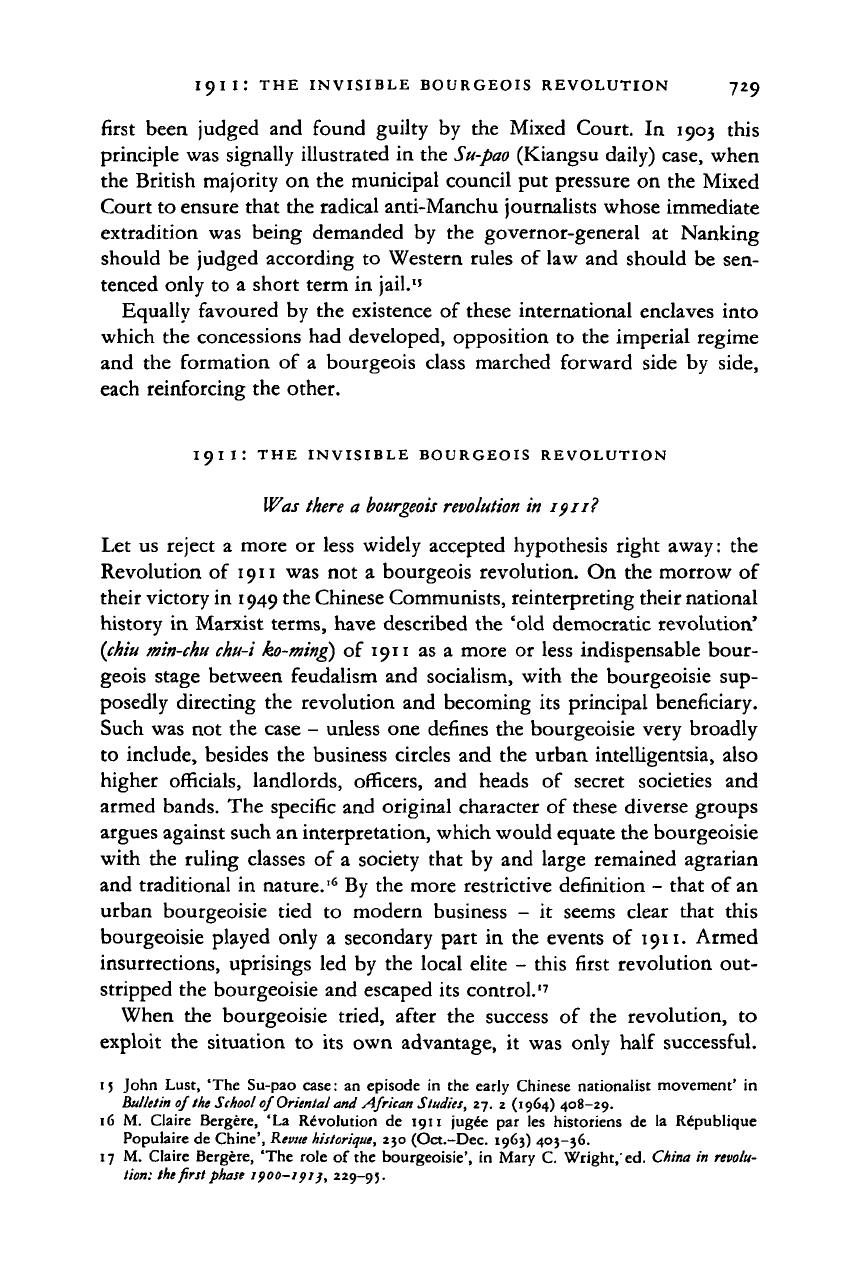
191 I : THE INVISIBLE BOURGEOIS REVOLUTION 729
first been judged and found guilty by the Mixed Court. In 1903 this
principle was signally illustrated in the
Su-pao
(Kiangsu daily) case, when
the British majority on the municipal council put pressure on the Mixed
Court to ensure that the radical anti-Manchu journalists whose immediate
extradition was being demanded by the governor-general at Nanking
should be judged according to Western rules of law and should be sen-
tenced only to a short term in jail.
1
'
Equally favoured by the existence of these international enclaves into
which the concessions had developed, opposition to the imperial regime
and the formation of a bourgeois class marched forward side by side,
each reinforcing the other.
191 i: THE INVISIBLE BOURGEOIS REVOLUTION
Was there a
bourgeois revolution
in
Let us reject a more or less widely accepted hypothesis right away: the
Revolution of 1911 was not a bourgeois revolution. On the morrow of
their victory in 1949 the Chinese Communists, reinterpreting their national
history in Marxist terms, have described the 'old democratic revolution'
(chiu min-chu chu-i ko-ming)
of 1911 as a more or less indispensable bour-
geois stage between feudalism and socialism, with the bourgeoisie sup-
posedly directing the revolution and becoming its principal beneficiary.
Such was not the case - unless one defines the bourgeoisie very broadly
to include, besides the business circles and the urban intelligentsia, also
higher officials, landlords, officers, and heads of secret societies and
armed bands. The specific and original character of these diverse groups
argues against such an interpretation, which would equate the bourgeoisie
with the ruling classes of a society that by and large remained agrarian
and traditional in nature.'
6
By the more restrictive definition - that of an
urban bourgeoisie tied to modern business - it seems clear that this
bourgeoisie played only a secondary part in the events of 1911. Armed
insurrections, uprisings led by the local elite - this first revolution out-
stripped the bourgeoisie and escaped its control.'
7
When the bourgeoisie tried, after the success of the revolution, to
exploit the situation to its own advantage, it was only half successful.
15 John Lust, 'The Su-pao case: an episode in the early Chinese nationalist movement' in
Bulletin
of
the School
of
Oriental
and African
Studies,
27. 2 (1964) 408-29.
16 M. Claire Bergere, 'La Revolution de 1911 jugee par les histohens de la Republique
Populaire de Chine',
Revue
historique,
230 (Oct.-Dec. 1963) 405-36.
17 M. Claire Bergere, 'The role of the bourgeoisie', in Mary C. Wright,'ed. China in
revolu-
tion:
the first
phase
ipoo-ip/), 229-95.
Cambridge Histories Online © Cambridge University Press, 2008
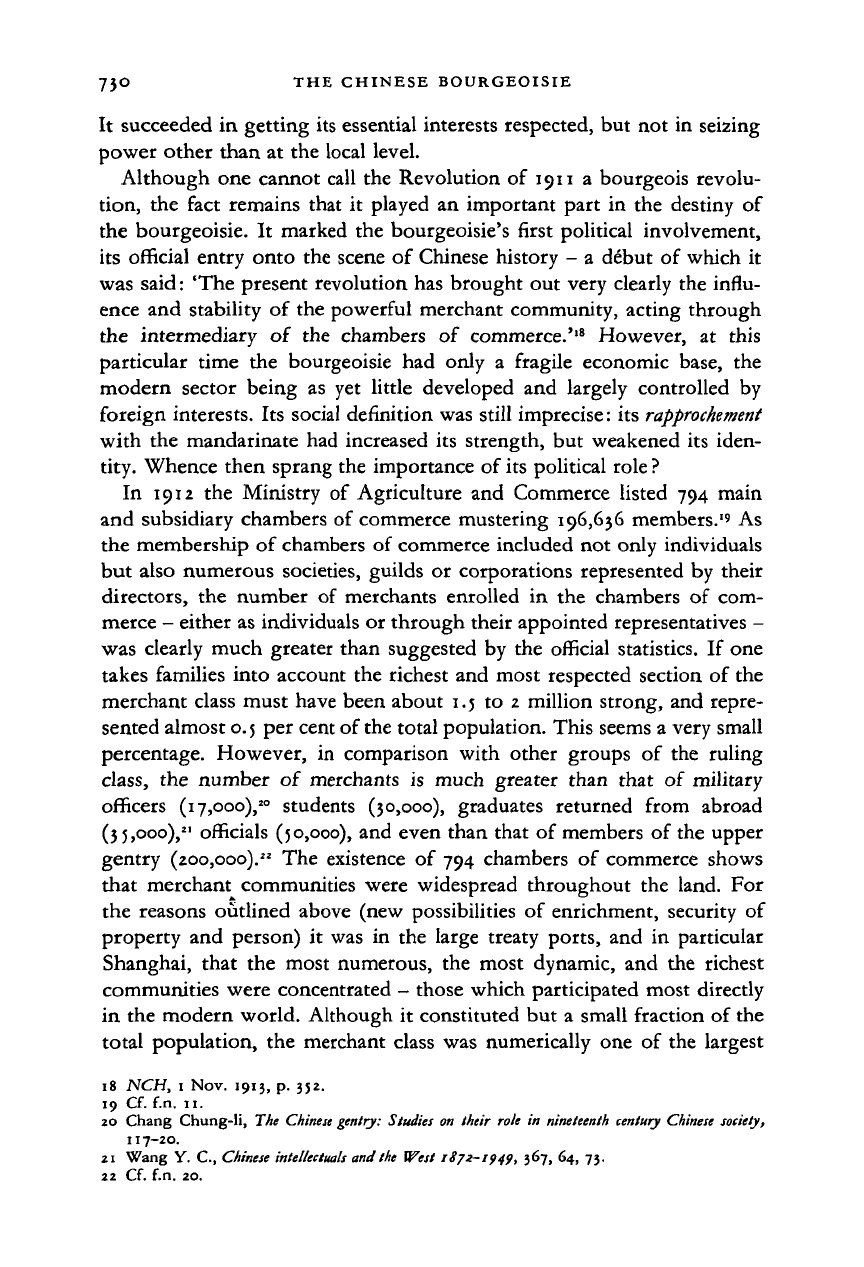
730 THE CHINESE BOURGEOISIE
It succeeded in getting its essential interests respected, but not in seizing
power other than at the local level.
Although one cannot call the Revolution of 1911 a bourgeois revolu-
tion, the fact remains that it played an important part in the destiny of
the bourgeoisie. It marked the bourgeoisie's first political involvement,
its official entry onto the scene of Chinese history - a debut of which it
was said: 'The present revolution has brought out very clearly the influ-
ence and stability of the powerful merchant community, acting through
the intermediary of the chambers of commerce.'
18
However, at this
particular time the bourgeoisie had only a fragile economic base, the
modern sector being as yet little developed and largely controlled by
foreign interests. Its social definition was still imprecise: its
rapprochement
with the mandarinate had increased its strength, but weakened its iden-
tity. Whence then sprang the importance of its political role
?
In 1912 the Ministry of Agriculture and Commerce listed 794 main
and subsidiary chambers of commerce mustering 196,636 members.
1
' As
the membership of chambers of commerce included not only individuals
but also numerous societies, guilds or corporations represented by their
directors, the number of merchants enrolled in the chambers of com-
merce - either as individuals or through their appointed representatives -
was clearly much greater than suggested by the official statistics. If one
takes families into account the richest and most respected section of the
merchant class must have been about 1.5 to 2 million strong, and repre-
sented almost
o.
5
per cent of the total population. This seems a very small
percentage. However, in comparison with other groups of the ruling
class,
the number of merchants is much greater than that of military
officers (17,000)/° students (30,000), graduates returned from abroad
(35,000)/' officials (50,000), and even than that of members of the upper
gentry (200,000)." The existence of 794 chambers of commerce shows
that merchant communities were widespread throughout the land. For
the reasons outlined above (new possibilities of enrichment, security of
property and person) it was in the large treaty ports, and in particular
Shanghai, that the most numerous, the most dynamic, and the richest
communities were concentrated
—
those which participated most directly
in the modern world. Although it constituted but a small fraction of the
total population, the merchant class was numerically one of the largest
18 NCH, 1 Nov. 1913, p. 352.
19 Cf. f.n. 11.
20
Chang Chung-li,
The
Chinese
gentry: Studies
on
their role
in
nineteenth century Chinese society,
117-20.
21 Wang Y. C,
Chinese intellectuals
and
the
West 1872-1949, 367, 64, 73.
22 Cf. f.n. 20.
Cambridge Histories Online © Cambridge University Press, 2008
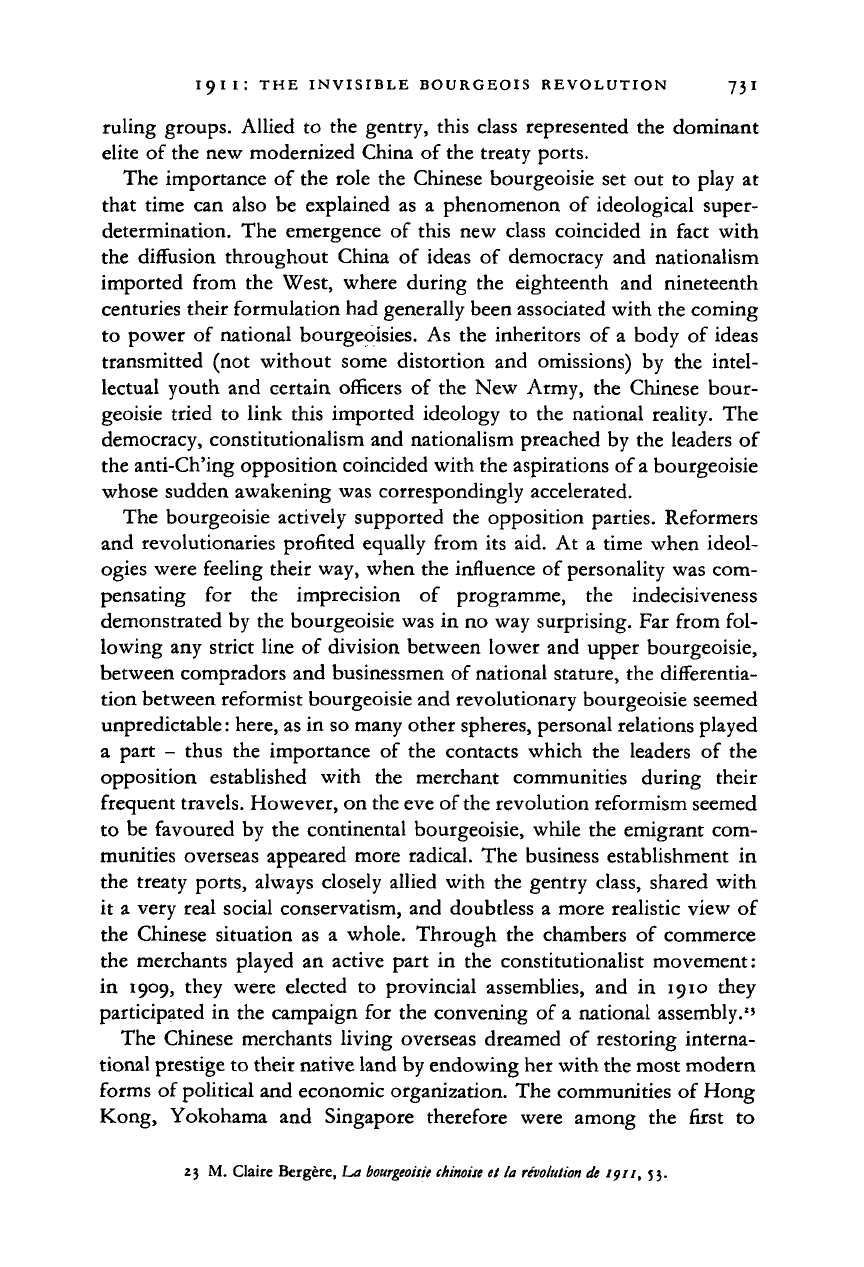
191 i: THE INVISIBLE BOURGEOIS REVOLUTION 73 I
ruling groups. Allied
to
the gentry, this class represented the dominant
elite
of
the new modernized China
of
the treaty ports.
The importance
of
the role the Chinese bourgeoisie set out
to
play
at
that time can also
be
explained
as a
phenomenon
of
ideological super-
determination. The emergence
of
this new class coincided
in
fact with
the diffusion throughout China
of
ideas
of
democracy and nationalism
imported from the West, where during
the
eighteenth
and
nineteenth
centuries their formulation had generally been associated with the coming
to power
of
national bourgeoisies. As the inheritors
of a
body
of
ideas
transmitted (not without some distortion
and
omissions)
by the
intel-
lectual youth and certain officers
of
the New Army,
the
Chinese bour-
geoisie tried
to
link this imported ideology
to
the national reality. The
democracy, constitutionalism and nationalism preached by the leaders
of
the anti-Ch'ing opposition coincided with the aspirations of
a
bourgeoisie
whose sudden awakening was correspondingly accelerated.
The bourgeoisie actively supported the opposition parties. Reformers
and revolutionaries profited equally from its aid.
At a
time when ideol-
ogies were feeling their way, when the influence of personality was com-
pensating
for the
imprecision
of
programme,
the
indecisiveness
demonstrated by the bourgeoisie was in no way surprising. Far from fol-
lowing any strict line
of
division between lower and upper bourgeoisie,
between compradors and businessmen of national stature, the differentia-
tion between reformist bourgeoisie and revolutionary bourgeoisie seemed
unpredictable: here, as in so many other spheres, personal relations played
a part
-
thus
the
importance
of
the contacts which
the
leaders
of
the
opposition established with
the
merchant communities during their
frequent travels. However, on the eve of
the
revolution reformism seemed
to be favoured by the continental bourgeoisie, while the emigrant com-
munities overseas appeared more radical. The business establishment
in
the treaty ports, always closely allied with the gentry class, shared with
it
a
very real social conservatism, and doubtless
a
more realistic view of
the Chinese situation
as a
whole. Through
the
chambers
of
commerce
the merchants played
an
active part
in
the constitutionalist movement:
in 1909, they were elected
to
provincial assemblies,
and in
1910 they
participated
in
the campaign for the convening
of
a national assembly.
2
'
The Chinese merchants living overseas dreamed
of
restoring interna-
tional prestige to their native land by endowing her with the most modern
forms of political and economic organization. The communities
of
Hong
Kong, Yokohama
and
Singapore therefore were among
the
first
to
23 M. Claire Bergere,
La
bourgeoisie chinoise
el la
revolution
de 1911, 55.
Cambridge Histories Online © Cambridge University Press, 2008
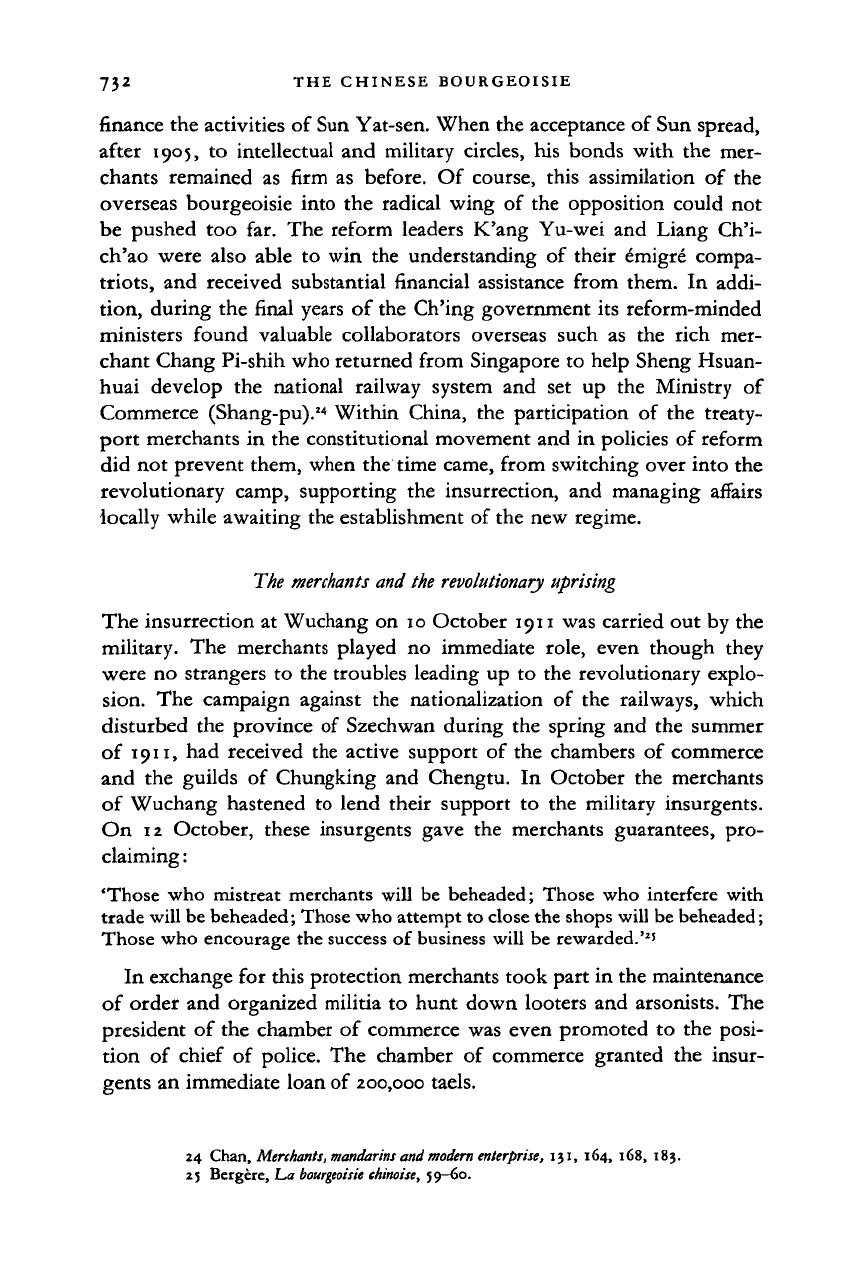
732 THE CHINESE BOURGEOISIE
finance the activities of Sun Yat-sen. When the acceptance of Sun spread,
after 1905, to intellectual and military circles, his bonds with the mer-
chants remained as firm as before. Of course, this assimilation of the
overseas bourgeoisie into the radical wing of the opposition could not
be pushed too far. The reform leaders K'ang Yu-wei and Liang Ch'i-
ch'ao were also able to win the understanding of their emigre compa-
triots,
and received substantial financial assistance from them. In addi-
tion, during the final years of the Ch'ing government its reform-minded
ministers found valuable collaborators overseas such as the rich mer-
chant Chang Pi-shih who returned from Singapore to help Sheng Hsuan-
huai develop the national railway system and set up the Ministry of
Commerce (Shang-pu).
24
Within China, the participation of the treaty-
port merchants in the constitutional movement and in policies of reform
did not prevent them, when the time came, from switching over into the
revolutionary camp, supporting the insurrection, and managing affairs
locally while awaiting the establishment of the new regime.
The
merchants
and the
revolutionary
uprising
The insurrection at Wuchang on 10 October 1911 was carried out by the
military. The merchants played no immediate role, even though they
were no strangers to the troubles leading up to the revolutionary explo-
sion. The campaign against the nationalization of the railways, which
disturbed the province of Szechwan during the spring and the summer
of 1911, had received the active support of the chambers of commerce
and the guilds of Chungking and Chengtu. In October the merchants
of Wuchang hastened to lend their support to the military insurgents.
On 12 October, these insurgents gave the merchants guarantees, pro-
claiming
:
'Those who mistreat merchants will be beheaded; Those who interfere with
trade will be beheaded; Those who attempt to close the shops will be beheaded;
Those who encourage the success of business will be rewarded.'
2
'
In exchange for this protection merchants took part in the maintenance
of order and organized militia to hunt down looters and arsonists. The
president of the chamber of commerce was even promoted to the posi-
tion of chief of police. The chamber of commerce granted the insur-
gents an immediate loan of 200,000 taels.
24 Chan, Merchants, mandarins
and
modem enterprise, 131, 164, 168, 183.
25
Bergere,
La
bourgeoisie
chinoise,
59-60.
Cambridge Histories Online © Cambridge University Press, 2008
